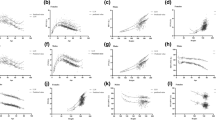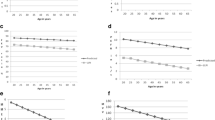Abstract
Objective
To develop prediction equations for spirometry for children from northern India using current international guidelines for standardization.
Design
Re-analysis of cross-sectional data from a single school.
Participants
670 normal children (age 6-17 y; 365 boys) of northern Indian parentage.
Methods
After screening for normal health, we carried out spirometry with recommended quality assurance according to current guidelines. We developed linear and nonlinear prediction equations using multiple regression analysis. We selected the final models on the basis of the highest coefficient of multiple determination (R2) and statistical validity.
Main outcome measures
Spirometry parameters: FVC, FEV1, PEFR, FEF50, FEF75 and FEF25-75.
Results
The equations for the main parameters were as follows: Boys, Ln FVC = -1.687+0.016*height +0.022*age; Ln FEV1 = - 1.748+0.015*height+0.031*age. Girls, Ln FVC = -9.989 +(2.018*Ln(height)) + (0.324*Ln(age)); Ln FEV1 = -10.055 +(1.990*Ln(height))+(0.358*Ln(age)). Nonlinear regression yielded substantially greater R2 values compared to linear models except for FEF50 for girls. Height and age were found to be the significant explanatory variables for all parameters on multiple regression with weight making no significant contribution.
Conclusions
We developed prediction equations for spirometry for children from northern India. Nonlinear equations were superior to linear equations.
Similar content being viewed by others
References
Chhabra SK. Interpretation of spirometry: Selection of predicted values and defining abnormality. Indian J Chest Dis Allied Sci. 2014;57:91–105.
Jain SK, Ramiah TJ. Prediction of ventilatory norms in healthy boys 7-14 years age. Indian J Med Res. 1967;55:69–79.
Vohra RS, Shah SC, Shah GS. Pulmonary functions in normal children. Indian Pediatr. 1984;21:785–90.
Malik SK, Jindal SK. Pulmonary function tests in healthy children. Indian Pediatr. 1985;22:677–81.
Gupta CK, Mishra G, Mehta SC, Prasad J. On the contribution of height to predict lung volumes, capacities and diffusion in healthy schoolchildren of 10-17 years. Indian J Chest Dis Allied Sci. 1993;35:167–77.
Chowgule RV, Shetye VM, Parmar JR. Lung function tests in normal Indian children. Indian Pediatr. 1995;32:185–91.
Raj Kapoor, Mahajan KK, Mahajan A. Ventilatory lung function tests in school children of 6-13 years. Indian J Chest Dis Allied Sci. 1997;39:97–105.
Vijayan VK, Reetha AM, Kuppurao KV, Venkatesan P, Thilakavathy S. Pulmonary function in normal south Indian children aged 7 to 19 years. Indian J Chest Dis Allied Sci. 2000;42:147–56.
Raju PS, Prasad KV, Ramana YV, Ahmed SK, Murthy KJ. Study on lung function tests and prediction equations in Indian male children. Indian Pediatr. 2003; 40:705–11.
Miller MR, Hankinson J, Brusasco V, Burgos F, Casaburi R, Coates A, et al. Standardisation of spirometry. Eur Respir J. 2005;26:319–38.
Chhabra SK, Vijayan VK, Rahman M, Mittal V, Singh PD. Regression equations for spirometry in children aged 6 to 17 years in Delhi region. Indian J Chest Dis Allied Sci. 2012;54:59–63.
Dickman ML, Schmidt CD, Gardner RM. Spirometric standards for normal children and adolescents (ages 5 years through 18 years). Am Rev Respir Dis. 1971;104:680–7.
Sherill DL, Camilli A, Lebowitz MD. On the temporal relationship between lung function and somatic growth. Am Rev Respir Dis. 1989;140:638–44.
Hankinson JL, Odencrantz JR, Fedan KB. Spirometric reference values from a sample of the general US population. Am J Respir Crit Care Med. 1999; 159:179–87.
Quanjer PH, Stocks J, Polgar G, Wise M, Karlberg J, Borsboom G. Compilation of reference values for lung function measurements in children. Eur Respir J Suppl. 1989;4:184S–261S.
Green SB. How many subjects does it take to do a regression analysis? Multivariate Behavioral Research. 1991;26:499 510.
Chhabra SK. Regional variations in vital capacity in adult males in India: comparison of regression equations from four regions and impact on interpretation of spirometric data. Indian J Chest Dis Allied Sci. 2009;51:7–13.
Aggarwal AN, Gupta D, Jindal SK. Comparison of Indian reference equations for spirometry interpretation. Respirology. 2007;12:763–8.
American Thoracic Society. Lung function testing: selection of reference values and interpretative strategies. Official statement of the American Thoracic Society. Am Rev Respir Dis. 1991;144:202–18.
Pellegrino R, Viegi G, Brusasco V, Crapo RO, Burgos F, Casaburi R, et al. Interpretative strategies for lung function tests. Eur Respir J. 2005;26:948–68.
Chatterjee S, Mandal A. Pulmonary function studies in healthy school boys of West Bengal. Jpn J Physiol. 1991;41:797–808.
Connett GJ, Quak SH, Wpm ML, Teo J, Lee BW. Lung function reference values in Singaporean children aged 6-18 years. Thorax. 1994;49:901–5.
Aggarwal AN, Gupta D, Behera D, Jindal SK. Applicability of commonly used Caucasian prediction equations for spirometry interpretation in India. Indian J Med Res. 2005;122:153–64.
Van Ganse WL, Billet L, Ferris B. Medical criteria for the selection of normal subjects. In: Arcangeli P, Cotes JE, Cournand A, Denolin H, Maria GD, Sadoul P, et al., editors. Introduction to the definition of normal values for respiratory function in man. Alghero, Italy: Panminerva Medica; 1969. P.15–27.
Author information
Authors and Affiliations
Corresponding author
Rights and permissions
About this article
Cite this article
Chhabra, S.K., Kumar, R. & Mittal, V. Prediction equations for spirometry for children from northern India. Indian Pediatr 53, 781–785 (2016). https://doi.org/10.1007/s13312-016-0930-0
Received:
Revised:
Accepted:
Published:
Issue Date:
DOI: https://doi.org/10.1007/s13312-016-0930-0




